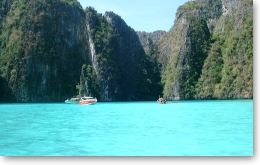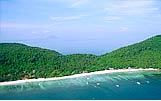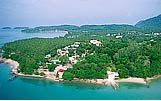Phuket – Facts and Figures
Location
Phuket Island is located in the Andaman Sea (Indian Ocean) 7 degrees north of the equator, just off the west coast of Southern Thailand. The island is linked at it’s northern point to Phang Nga province, on the Thai mainland by the Sarasin Bridge. Bangkok is approximately 900 km north by road and about 1 hour by air. Singapore is approximately 1600 km to the south by road and just over 1 1/2 hours by air.
Area and Topography
Phuket is the largest island, but the second smallest province of Thailand. With an area of 539 square kilometers the main island is about the same size as Singapore. Several smaller offshore islands increase the total area to 570 Sq. Km. Almost 80 percent of the island is mountainous, with almost 50 percent still forested (jungle) and a further 25 percent under rubber plantation.
Climate
Phuket has a two season tropical climate. The rainy season runs from April to November and the hot (predominantly dry season) from December to March. The prevailing winds are from the south west during the rainy season and from the east during the hot season. These sea breezes cool and stabilize the climate, making Phuket much cooler than Bangkok. Outside of a few weeks in November, average daytime temperatures rarely move outside the 30 to 35 Celsius range. Average rainfall is 1,600 mm (62 inches) per year
Population
 The last official census showed about 250,000 people living in Phuket. Since this figure only includes those registered as resident in Phuket and there is a significant (semi permanent) work force form other provinces of Thailand as well as many semi resident foreigners not to mention up to 75,000 visitors at any one time, it is likely that a more realistic figure would be in the range of 500,000.
The last official census showed about 250,000 people living in Phuket. Since this figure only includes those registered as resident in Phuket and there is a significant (semi permanent) work force form other provinces of Thailand as well as many semi resident foreigners not to mention up to 75,000 visitors at any one time, it is likely that a more realistic figure would be in the range of 500,000.
Languages and Religions
The official language is standard Thai, but a local south Thai dialect is widely spoken - and the large indigenous Chinese minority still makes limited use of Hokien and other Chinese dialects. 75 percent of the islanders are Buddhist (this includes the Chinese Buddhists), 22 percent Muslim and 3 percent Christian. There are 30 main Buddhist temples, 34 Mosques and 2 churches.
Commerce and Industry
Tin ore mining, marine products, rubber, coconut and pineapples have traditionally been the main products of Phuket. Tin was very significant until the early 1980s and contributed significantly to the island’s reputation as the wealthiest province outside Bangkok. The decline of tin (which may well start to grow again - with rising commodity prices) was largely replaced by Tourism. Annual tourist arrivals, under half a million in 1987, passed two million in 1994, three million in 1999 and exceeded 4,000,000 in 2002. Tourism is now far and away the islands most significant source of revenue.


